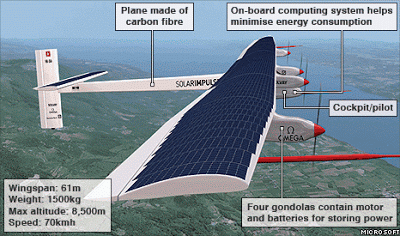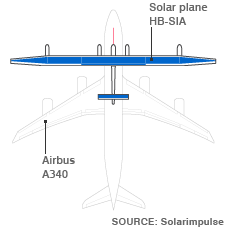Solar plane to make public debut
By Jonathan Amos / June 26, 2009
Swiss adventurer Bertrand Picard is set to unveil a prototype of the solar-powered plane he hopes eventually to fly around the world.
The initial version, spanning 61m but weighing just 1,500kg, will undergo trials to prove it can fly at night.
Mr Picard, who made history by circling the globe non-stop in a balloon in 1999, says he wants to demonstrate the potential of renewable energies.
He expects to make a crossing of the Atlantic in 2012.
The flight would be a risky endeavour. Only now is solar and battery technology becoming mature enough to sustain flight through the night – and then only in unmanned planes.
But Picard’s Solar Impulse team has invested tremendous energy – and no little money – in trying to find what they believe is a breakthrough design.
“I love this type of vision where you set the goal and then you try to find a way to reach it, because this is challenging,” he told BBC News.
Testing programme
The HB-SIA has the look of a glider but is on the scale – in terms of its width – of a modern airliner.
The aeroplane incorporates composite materials to keep it extremely light and uses super-efficient solar cells, batteries, motors and propellers to get it through the dark hours.
Picard will begin testing with short runway flights in which the plane lifts just a few metres into the air.
As confidence in the machine develops, the team will move to a day-night circle. This has never been done before in a piloted solar-powered plane.
HB-SIA should be succeeded by HB-SIB. It is likely to be bigger, and will incorporate a pressurised capsule and better avionics.
It is probable that Picard will follow a route around the world in this aeroplane close to the path he took in the record-breaking Breitling Orbiter 3 balloon – going from the United Arab Emirates, to China, to Hawaii, across the southern US, southern Europe, and back to the UAE.
Measuring success
Although the vehicle is expected to be capable of flying non-stop around the globe, Picard will in fact make five long hops, sharing flying duties with project partner Andre Borschberg.
“The aeroplane could do it theoretically non-stop – but not the pilot,” said Picard.
“We should fly at roughly 25 knots and that would make it between 20 and 25 days to go around the world, which is too much for a pilot who has to steer the plane.
“In a balloon you can sleep, because it stays in the air even if you sleep. We believe the maximum for one pilot is five days.”
The public unveiling on Friday of the HB-SIA is taking place at Dubendorf airfield near Zürich.
“The real success for Solar Impulse would be to have enough millions of people following the project, being enthusiastic about it, and saying ‘if they managed to do it around the world with renewable energies and energy savings, then we should be able to do it in our daily life’.”
Source / BBC News
Thanks to Deva Wood / The Rag Blog




















The best potential for low energy flight is likely dirigibles filled with hydrogen or helium. Since we are running out of helium, I guess it should be hydrogen.
One of the most appropriate uses would be logging where there are no roads. The soviets once considered them for moving very large weights at low cost. High fuel prices might revive that idea. I can think of no other way to move a large house intact.